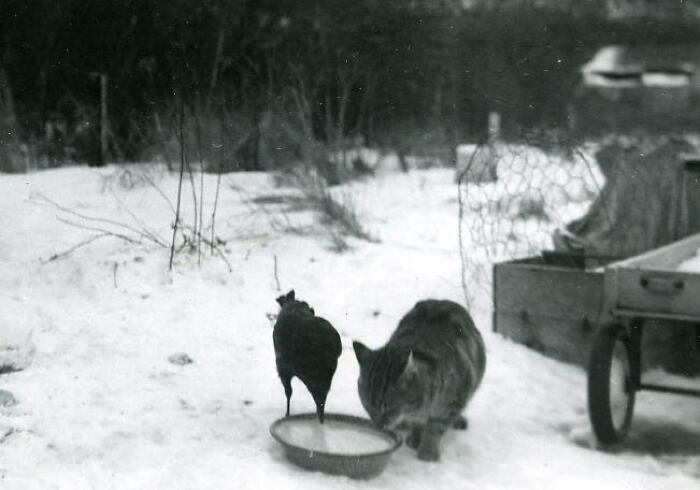Cat — Kuskaq
Kuskat qungutuartut.—Cats are pets.

Photo: A cat and a crow share a dish of food, Larsen Bay, ca. 1955. Courtesy of Tim and Norman Smith
The lynx (Lynx canadensis) is the only species of wild cat found in Alaska and it is not indigenous to the Kodiak region. In the Alutiiq world, lynxes are found in the wooded environments of the northern Alaska Peninsula, Kenai Peninsula, and Prince William Sound. They subsist on small game, particularly hares, and have a plush, spotted, grey coat. Alutiiq people trapped lynx for their soft, dense fur, which was used in parkas. Lynx pelts were also a valuable commodity during the historic fur trade. Sizeable quantities of lynx pelts harvested on the Alaska mainland passed through Kodiak on their way to European markets.
Alutiiq people distinguish between lynxes and domestic cats, with different words for each. Elders say that rabbits resemble kuskat—domestic cats, and the Alutiiq word for rabbit or hare is kuskaanaq. This means something like a cat.
Today, domestic cats are part of village life but when were they introduced to Kodiak? Photographs show cats in Alutiiq households by at least the 1960s, but they were likely introduced to the island much earlier. One possibility is that cats came to Kodiak on European sailing ships. Although cats dislike the water, they often accompanied sailors on long voyages to kill the mice and rats that could destroy lines, eat supplies, and spread disease.
Alutiiq people distinguish between lynxes and domestic cats, with different words for each. Elders say that rabbits resemble kuskat—domestic cats, and the Alutiiq word for rabbit or hare is kuskaanaq. This means something like a cat.
Today, domestic cats are part of village life but when were they introduced to Kodiak? Photographs show cats in Alutiiq households by at least the 1960s, but they were likely introduced to the island much earlier. One possibility is that cats came to Kodiak on European sailing ships. Although cats dislike the water, they often accompanied sailors on long voyages to kill the mice and rats that could destroy lines, eat supplies, and spread disease.
